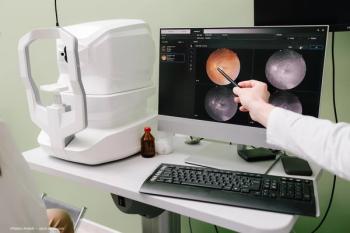In celebration of 50 years of innovation, Ophthalmology Times invited leading experts and rising voices across the field to reflect on the most pivotal advances in eye care. From anti-VEGF therapies to revolutionary imaging tools, the last 5 decades have redefined what’s possible in ophthalmology. What emerged was a striking consensus: Progress has not only preserved vision—it has restored it, streamlined interventions, and deepened our understanding of ocular disease at a cellular level.
Anti-VEGF Therapy: A Defining Breakthrough
Many clinicians pointed to the advent of anti-VEGF therapy as the single most transformative innovation in modern ophthalmology.
Carl Danzig, MD, emphasized the dual revolution brought about by anti-VEGF agents and optical coherence tomography (OCT) imaging, which together reshaped disease management and outcomes for patients with retinal vascular diseases. “You had a drug that treated conditions like wet AMD [age-related macular degeneration] and DME [diabetic macular edema] and a diagnostic tool that let you assess its impact in real time,” he said.
“Anti-VEGF injections have revolutionized our ability to treat diseases like wet AMD, diabetic retinopathy, RVO [retinal vein occlusion], and even retinopathy of prematurity,” said Nimesh Patel, MD. “These were once blinding conditions, now managed with minimally invasive medical treatments.”
Christine Kay, MD, added that anti-VEGF set the stage for subsequent breakthroughs in sustained delivery systems and gene therapy: “The 2017 approval of voretigene neparvovec for RPE65-associated retinal dystrophy marked a paradigm shift. We’re entering a new era of augmentation and gene replacement therapy.”
Ferhina Ali, MD, MPH, emphasized how the synergy between anti-VEGF agents and OCT imaging has preserved not just sight but quality of life. “Patients can now maintain 20/30 vision and continue driving, which was unthinkable 50 years ago.”
Key Innovations Recognized by Experts:
- Optical coherence tomography (OCT)
- Gene therapy and sustained delivery systems
- Minimally invasive and small-incision surgery
- Advances in corneal transplantation and phacoemulsification
- Artificial intelligence in imaging and diagnosis
- Global accessibility of intraocular lenses
- Myopia control as a public health priority
Multiple experts also underscored the broad utility of anti-VEGF agents across diseases. “It works for so many conditions—wet AMD, diabetic retinopathy, RVO, and even ROP [retinopathy of prematurity],” said Patel. Others, including Anat Loewenstein, MD, MHA, and Dimitra Skondra, MD, PhD, noted that sustained-release formulations and gene therapies mark the next evolution in anti–VEGF-based treatment paradigms.
OCT and Imaging: Visualizing the Invisible
If anti-VEGF therapies transformed treatment, OCT revolutionized diagnosis and monitoring. OCT has allowed clinicians to visualize and monitor retinal pathology in vivo with precision and clarity. Numerous clinicians called OCT the most significant diagnostic advancement of the last 50 years. “It’s equivalent to Helmholtz discovering the ophthalmoscope,” said Alfredo Sadun, MD, PhD.
Yuhua Zhang, PhD, credited OCT and adaptive optics as catalysts for clinical and scientific discovery: “They enabled us to study retinal structure at the cellular level—something previously reserved for histology labs and donor tissue.”
Dilsher Dhoot, MD, FASRS, echoed the sentiment: “OCT fundamentally changed how we diagnose, monitor, and evaluate treatment efficacy. It's a cornerstone of modern retina care.”
“OCT is like the ophthalmoscope of our era—it’s allowed us to see disease at a remarkable level.”— Alfredo Sadun, MD, PhD
Barsha Lal, PhD, and Paul Hammond, OD, FAAO, also highlighted OCT’s impact in glaucoma and early disease detection, describing it as a game changer in diagnostics and disease progression management.
Surgical Advances: Smaller, Safer, Smarter
Corneal and retinal surgeries have undergone profound changes, and minimally invasive techniques have enhanced outcomes across subspecialties. Jennifer Lim, MD, cited innovations in vitrectomy, small-gauge instrumentation, and perfluorooctane use as game changers in retinal detachment repair.
Christina Prescott, MD, PhD, traced the dramatic shift from full-thickness keratoplasty to Descemet stripping endothelial keratoplasty (DSEK), Descemet membrane endothelial keratoplasty (DMEK), and now cell-based therapies. “It’s been an evolution that became a revolution,” she said. “We’ve evolved from full-thickness keratoplasty to DSEK, DMEK, and now cell therapy. It’s a complete paradigm shift.”
Ellen Koo, MD, traced a similar arc in cataract surgery: “Phacoemulsification has revolutionized cataract management. Combined with premium IOLs, it represents one of the most important surgical innovations in ophthalmology.”
Phacoemulsification also received praise as a cornerstone development in cataract surgery. “It’s hard to overstate how transformative it was,” said Roger Goldberg, MD, MBA, noting the downstream impact on IOL implantation and refractive outcomes.
Gene Therapy and the Genomic Horizon
Several contributors underscored the early success and future potential of gene-based treatments. Skondra acknowledged gene therapy’s proof of concept while urging the field to think beyond single-gene targets: “We need more inclusive, agnostic approaches that can be applied more broadly.”
C. Michael Samson, MD, MBA, connected the dots: “Our comfort with intravitreal drug delivery has laid the groundwork for these therapies. Without that, gene therapy might still be theoretical.”
“Without intravitreal drug delivery experience, gene therapy wouldn't be where it is today.” — C. Michael Samson, MD, MBA
Artificial Intelligence and the Data Revolution
The integration of artificial intelligence (AI) into ophthalmology is a frontier still unfolding. John Tan and Cameron Cummings praised AI’s potential in accelerating diagnosis, triage, and population-level screening, while Anisha Kasi noted its growing synergy with OCT.
“AI in ophthalmology will change screening and diagnostics just as it has in other fields.” — Cameron Cummings
Noemi Guemes-Villahoz, MD, PhD, offered a poignant reminder: “AI and tech matter, but people—physicians—are the real drivers of change. Our mission remains the same: to care for patients.”
Public Health and Global Access
Innovation’s true power lies in its reach. Jogin Desai, MD, cited the widespread accessibility of low-cost IOLs as a prime example. “Innovation is not just invention—it’s making that invention accessible to millions.”
Mark Bullimore, MCOptom, PhD, offered a public health perspective on myopia management, once considered benign. “We now understand that myopia is a major cause of uncorrectable visual impairment,” he said. Interventions that slow axial elongation in children are now recognized as essential preventive strategies.
What Lies Ahead
Reflecting on the rapid pace of change, many ophthalmologists acknowledged that the next 50 years promise even more dramatic advances. From longer-acting therapeutics to real-time AI decision support, ophthalmology is poised to continue its trajectory as one of the most technologically advanced specialties in medicine.
Nitish Mehta, MD, concluded, “We’re on the cusp of another leap forward. Soon, we’ll treat chronic blinding diseases with fewer interventions and greater precision. It’s an exciting time to be in ophthalmology.”
“We must remember—the greatest innovation is us, the people who care for patients.” — Noemi Guemes-Villahoz, MD, PhD
As ophthalmology celebrates its half-century of progress, the message from its practitioners is clear: This is a field shaped not only by remarkable technology but also by the people who pioneer, adapt, and apply it to transform patients’ lives.














































